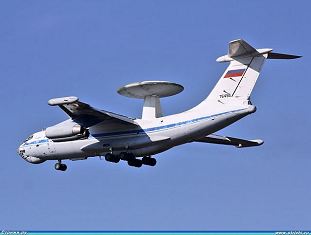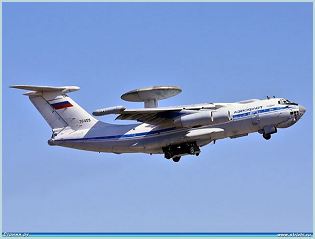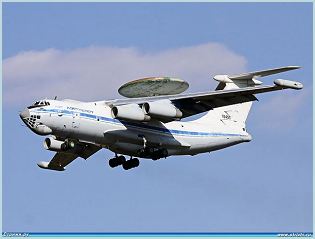A-50 Beriev Mainstay
| a | ||||||||||||||||||||||
|
A-50 AWACS Mainstay Airborne early warning and control system aircraft
|
||||||||||||||||||||||
 |
||||||||||||||||||||||
|
|
||||||||||||||||||||||
|
The Beriev A-50 (NATO reporting name: Mainstay) is a Russian airborne warning and control system (AWACS) aircraft based on the Ilyushin Il-76 transport. The A-50 airborne early warning and control aircraft (AEW&C) was developed and manufactured by the Beriev Aircraft Research and Engineering Complex Joint Stock Company to replace the Tupolev Tu-126 'Moss', the A-50 first flew in 1978. It entered service in 1984, with about 40 produced by 1992. The A-50 entered service with the Russian Air Force in 1984. Currently, 16 aircraft are operational in the Russian Air Force. In November 2011, the new version A-50U entered in service in the Russian Air Force. |
||||||||||||||||||||||
| Variants | ||||||||||||||||||||||
|
|
||||||||||||||||||||||
|
||||||||||||||||||||||
|
|
||||||||||||||||||||||
|
||||||||||||||||||||||
|
|
||||||||||||||||||||||
|
||||||||||||||||||||||
|
|
||||||||||||||||||||||
|
||||||||||||||||||||||
|
|
||||||||||||||||||||||
|
||||||||||||||||||||||
| Technical Data | ||||||||||||||||||||||
| Design | ||||||||||||||||||||||
|
The A-50 is based on the Ilyushin Il-76 transport aircraft, but the majority of the modifications have been performed by Beriev. In comparison to the original airframe, the A-50 incorporates a lengthened fuselage with space for display consoles and communications sytems for the 10 mission specialists. A large rotating radome mounted is mounted above the fuselage. Installed in the forward portion of the radome is the antenna for the surveillance radar while the after section houses various data-link systems that allow the A-50 to vector up to 10 or 12 interceptors at once.
|
||||||||||||||||||||||
| Avionics | ||||||||||||||||||||||
|
The A-50 AWACS is equipped with a flight control and navigation system used to ensure air navigation at all flight stages, in VFR and 1FR conditions, by day and night, in any season and in all latitudes. The system also provides flight control and navigation data intended for special systems. The aircraft's electronic equipment enables the crew to perform combat missions in a hostile ECM environment.
The A-50 AWACS is fitted with the NPK-T flight control and navigation system used to ensure air navigation during all flight stages in all-weather day and night and all-year operations performed at all geographical latitudes. The system also provides flight control and navigation data intended for mission specific systems and equipment. |
||||||||||||||||||||||
| Propulsion | ||||||||||||||||||||||
|
The A-50 AWACS is motorized with four Aviadvigatel PS-90A turbofan, 157 kN each. The A-50 carries out patrol missions at an altitude of 5,000m to 10,000m. The patrol service ceiling is 10km. The maximum flight range of the aircraft is 5,000km and the flight endurance is seven hours 40 minutes. At a range of 2,000km, the A-50 can remain on patrol for up to one hour 25 minutes. The maximum take-off weight of the A-50 is 170,000kg. It can travel at a maximum speed of 800km/h.
|
||||||||||||||||||||||
| Capabilies | ||||||||||||||||||||||
|
The A-50 AWACS is manned by five flight crew and ten mission crew. Intended to detect and identify air objects, determine their coordinates and flight path data, transfer information to command posts, and direct fighter-interceptors and front-line aircraft to combat areas for attacking ground targets from low altitudes.
The airborne radar early warning and control system comprises: - a radar; - a data pickup and display system; - an interrogator-responder and signal transmission system; - a digital computer system; - IFF equipment; - a command radio-control link; - an encoding communications system; - communications equipment; - telemetry/code equipment; - registering equipment. To protect the aircraft during flights en-route and over patrol zones, it is provided with a self-defense system. The self-defense system ensures the aircraft's protection against guided and unguided weapons of enemy fighters attacking the aircraft from the front and aft hemispheres. The aircraft can also be protected from enemy fighters by directing friendly interceptors. |
||||||||||||||||||||||
| Specifications | ||||||||||||||||||||||
|
||||||||||||||||||||||
 |
||||||||||||||||||||||
|
||||||||||||||||||||||
|
a a
|
||||||||||||||||||||||




































